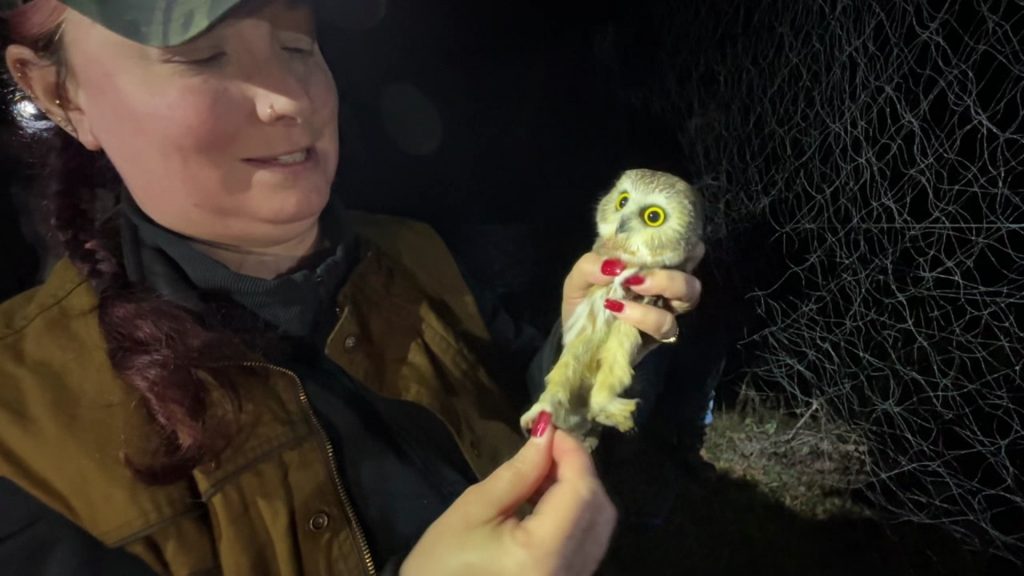Second-year Ph.D. student Mary Ann Bogert, a teaching and research assistant, has spent the past four years banding owls to research differences in migration patterns between male and female Northern Saw-whet owls.
Northern Saw-whet owls are tiny, less than a foot tall with a foot-and-a-half wingspan, and they weigh about as much as a stick of butter. They hunt and eat rodents but are sometimes preyed upon by larger owls. Because of this, they live in environments with coniferous trees, which provide them a place to hide even in the winter months. Generally, Northern Saw-whet owls migrate between the Canada and upstate New York area and West Virginia.
Bogert heads her field site, which she started in 2020, centering her research on the differences between male and female Northern Saw-whet owl migration patterns. Banders across the country broadcast male mating calls, subsequently attracting females and allowing researchers to capture them. They then place unobtrusive U.S. Geological Survey bands with individualized numbers on them on the birds. If that bird is caught again by another bander, they’ll be able to tell where the bird was banded, giving them information about the distance the birds have traveled.
Researchers have a lot of information about females’ movement but much less about males, and Bogert’s site is one of only two banding stations that also broadcast female mating calls to attract male owls. Without these stations, researchers would have more limited information about male migration patterns.
“Prior to [these two sites], we just hypothesized that males typically will stay closer to the breeding grounds to reclaim suitable habitat for their breeding season, and they mate in the lower part of Canada, upper part of New York,” Bogert said. “But now, between myself and the other research site that is doing this work, we’re seeing that males are more migratory than we have known previously.”
Once owls are caught, their sex is not always clear. Northern Saw-whet owls aren’t sexually dimorphic, which means that there aren’t any external sex characteristics researchers could use to identify males and females. Instead, they have to use what Bogert referred to as a “discriminant function analysis.” Female Northern Saw-whet owls tend to be heavier and have longer wings, so weight and wingspan are often used to determine the owl’s sex. Still, many owls fall in between the average male and female weight or wingspan, and their blood can be drawn to determine sex.
When she isn’t researching, or working on either of her dissertations — one on owl-banding, another on remedying inequality in STEM education — Bogert teaches two classes at BU, BIO 115, an introductory biology lab course, and How To Live A Meaningful Life, a University course for freshmen. Although neither of these courses is about owl-banding, Bogert said she always invites students to come to her research sites — she herself learned about bird banding from a trip in college, and she wants to pay it forward.
“I want other people to be able to have that experience because it changed my life and it might change somebody else’s life,” Bogert said.
Some of those students just attend one trip, but others discover a passion for working with owls and have visited Bogert many times. A few students have even pursued degrees in wildlife or ornithology following their experience.
It’s not just for students, as Bogert described how learning about bird-banding and visiting a site can open people’s minds to conservation. She keeps her site open to the public to make that experience accessible to as many people as possible.
Moving forward, Bogert looks to expand her research to other owl species, as she only bands the Northern Saw-whet owls between October and November. She recently attended a workshop dedicated to working with larger birds and expressed interest in researching short-eared owls, turkeys and black vultures.
A few weeks ago, students taking Birds and Bugs, a course taught by Steven Tammariello, the associate chair of the biology department, visited Bogert’s research site in Pennsylvania. One student in the class, Rory Shupp, an undeclared freshman, said the class trip sparked her interest in bird-watching.
“The researchers were super nice to us, and although we didn’t catch any owls that night, I think that it was still a really fun experience,” Shupp said.



